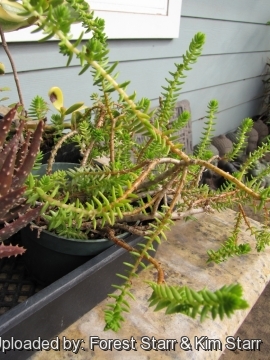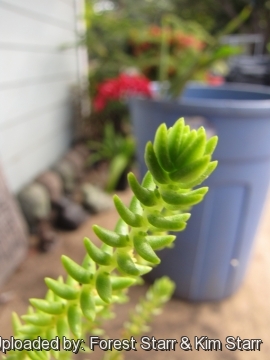
Crassula ericoides Photo by: Forest Starr & Kim Starr
Habit at Kula Botanical Garden, Maui, Hawaii (USA). March 07, 2011.
Origin and Habitat: Crassula ericoidesSN|27360]]SN|27360]] is native to the coastal belt from Bredasdorp in south-western Cape (South africa) to Eshowe in KwaZulu-Natal. It is a horticultural species; known to be naturalised in Hazelbrook (Central Tablelands) and Victoria, New South Wales, Australia.
Habitat and ecology: This specie grows in grassland, sandy flats, and coastal habitats among granite boulders.
Synonyms:
See all synonyms of Crassula ericoides
Common Names include:
ENGLISH: Large whipcord
AFRIKAANS (Afrikaans): Heideplakkie
CHINESE (中文): 方鳞若绿
Description: Crassula ericoidesSN|27360]]SN|27360]] is an erect perennial subshrubby, succulent species from 12 to 30(-40) cm high, with short, flat ericoid leaves, densely packed along the stem and a dense head of white tubular flowers partly concealed by upper leaves.
Stem: More or less branched usually erect, dichotomous and fastigiate, rarely decumbent or prostrate and woody. Branches are annulated, glabrous or with few spreading hairs particularly below inflorescences, naked with flaking bark on older branches, closely imbricated with leaves above.
Leaves: Leaves quadrifariously imbricated in closely alternating pairs, (2-)3-7 long, 1-3(-4) mm wide, ovate or ovate-lanceolate, sessile, subcordate at base, erect, pointed, dorsiventrally flattened, glabrous, green. Margins entire sub-recurved. Leaves imbricated in closely alternating pairs, 3–4 lines long, 2–3 lines wide, subacute.
Inflorescences: A terminal, sessile, rounded thyrse, partly concealed by upper leaves with one to several dichasia (a branch bearing a flower that gives rise to two other flowering branches), with 3–8 shortly pedicellate flowers.
Flowers: White, inconspicuous star-like, bisexual. Corolla tubular, fused at base for 0,2-0,3 mm, white or cream. Calyx-lobes nearly equalling the corolla, glabrous. Sepals 2-4 mm, linear, acute or bluntly acute, convex, ridged to keeled towards apex, fleshy, papillose, green. Petals nearly free, spreading, 3-5 mm elliptic-oblong, the petal tips erect and acute sharply acute, white, concave and more or less folded and ridged on back. Stamens 3-4 mm, anthers brown. Squamae transversely oblong, 0,2-0,4 x 0,4-0,6 mm, often slightly emarginate, sometimes constricted downwards, fleshy, pale yellow or white. Styles subulate as long as ovaries.
Subspecies, varieties, forms and cultivars of plants belonging to the Crassula ericoides group
 Crassula ericoides Haw.: has short leaves 3-7 x 1-3 mm densely arranged in four opposite ranks up the stem, rather like an Erica. Distribution: from Bredasdorp (Cape) to Eshowe in KwaZulu-Natal.
Crassula ericoides Haw.: has short leaves 3-7 x 1-3 mm densely arranged in four opposite ranks up the stem, rather like an Erica. Distribution: from Bredasdorp (Cape) to Eshowe in KwaZulu-Natal.- Crassula ericoides subs. tortuosa Toelken: is a prostrate form found at high altitudes in the mountains of the Little Karoo.
Bibliography: Major references and further lectures
1) Forest & Kim Starr “Crassula ericoides (crassula)”. Plants of Hawaii. <http://www.starrenvironmental.com>. Web. 27 Sep. 2014.
2) Gordon Rowley “Crassula: A Grower's Guide” Cactus & Company, 2003
3) Toelken, H.R. 1997. “A revision of the genus Crassula” in southern Africa. Annals of the Bolus Herbarium 8,1-595.
4) Urs Eggli “Illustrated Handbook of Succulent Plants: Crassulaceae” Springer Berlin Heidelberg, 05/Nov/2012
5) Jacobsen “Lexicon of succulent plants” Littlehampton Book Services Ltd. 1974
6) Doreen Court “Succulent Flora of Southern Africa” CRC Press, 01/Jun/2000
7) James Cullen, Sabina G. Knees, H. Suzanne Cubey “The European Garden Flora Flowering Plants: A Manual for the Identification of Plants Cultivated in Europe, Both Out-of-Doors and Under Glass” Cambridge University Press, 11/Aug/2011
8) Pauline Bohnen “Flowering plants of the Southern Cape” Still Bay Trust, 1986
9) Dr J.P. Roux “Flora of South Africa” 2003
10) W. H. Harvey “Flora Capensis” Vol 2, page 327 1894
11) KL Wilson (Jan 2009) “Crassula ericoides Haw.” New South Wlales Flora Online <http://plantnet.rbgsyd.nsw.gov.au/> Web. 27 Sep. 2014.
 Habit at KiHana Nursery Kihei, Maui, Hawaii (USA). February 15, 2011. Photo by: Forest Starr & Kim Starr
Habit at KiHana Nursery Kihei, Maui, Hawaii (USA). February 15, 2011. Photo by: Forest Starr & Kim Starr Leaves at KiHana Nursery Kihei, Maui, Hawaii (USA). February 15, 2011. Photo by: Forest Starr & Kim Starr
Leaves at KiHana Nursery Kihei, Maui, Hawaii (USA). February 15, 2011. Photo by: Forest Starr & Kim StarrCultivation and Propagation: Crassula ericoidesSN|27360]]SN|27360]] is not difficult to cultivate, loves heat and is easy to root and grow. It thrive with bright light and ample airflow. It makes a small erect shrub in subtropical climates and is drought tolerant and only want light watering. It is a rapid grower, to make new plants simply place leaves in soil within days you have a new plant!
Soil: It grows best in sandy-gritty soil. Good drainage is very important as it is prone to root rot.
Repotting: Repot every two years in spring. Do not radically cut off roots: about 10 percent of the root ball is right.
Fertilization: Feed it from mid spring to early autumn every four or five weeks with a fertilizer specifically formulated for cactus and succulents (poor in nitrogen), including all micro nutrients and trace elements diluted to ½ the strength recommended on the label. Do not feed plants during winter.
Watering Needs: It is a dry-tolerant plant. Water regularly in the growing season, but avoid water-logging and let dry between waterings. Water with caution in winter, as the plant can lose its roots if the soil stays cold and wet for extended periods. The lower the temperature the less water is needed. If grown in a container, bottom watering by immersing the container is recommended. Mist spraying is not needed, it must have very dry atmosphere.
Sun Exposure: Does well in filtered sun, but can handle some shade, too. It can be sunburned if moved from shade/greenhouse into full sun too quickly. It tends to get leggy in deep shade.
Frost Tolerance: Protect from frost to prevent scarring. It requires a minimum temperature of about 5°C, but will take a light frost and is hardy down to -5° C for short periods if it is in dry soil. USDA zones 9A – 11. In areas prone to frost, grow in an intermediate greenhouse or conservatory, in pots. The plant may be kept indoors throughout the year at a minimum winter temperature of 10°C not exceeding 18°C. In summer, the temperature will rise higher, but as this is accompanied by better light it does not matter. In colder climates plant this in a container, so it can be moved into a protected area when cold.
Garden uses: They make wonderful rocker plants in hot, dry areas and also grow well in containers or luminous patios.
Pests and diseases: May be susceptible to mealybugs and rarely scale. Protect from cold.
Maintenance: Whit time plants get quite long-shanked with dried flowering stalk and so trim them back substantially.
Propagation: From seed but it is easily increased by cuttings. Cuttings root easily. It is also possible, to plant the leaves in good, sandy soil where they will take root - members of this family often propagate vegetatively in this way. Take leaf cuttings in spring and summer. Detach a leaf from an established plant by pulling or bending, and leave it to dry for a day. Place the broken leaves on a mix of one part slightly moist peat and two parts sharp sand they will later grow roots. The leaf cutting can then be repotted.












